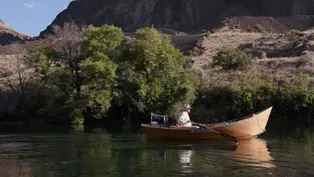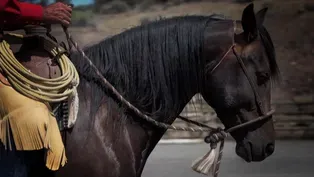Oregon Field Guide
Apple Bots
Clip: Season 34 Episode 9 | 6m 34sVideo has Closed Captions
The robots are coming … to pick Northwest apples!
Science fiction is fast becoming a reality on the apple orchards of Central Washington, where farmers facing labor shortages are testing out robots that could be the fruit pickers of the future.
Problems with Closed Captions? Closed Captioning Feedback
Problems with Closed Captions? Closed Captioning Feedback
Oregon Field Guide is a local public television program presented by OPB
Oregon Field Guide
Apple Bots
Clip: Season 34 Episode 9 | 6m 34sVideo has Closed Captions
Science fiction is fast becoming a reality on the apple orchards of Central Washington, where farmers facing labor shortages are testing out robots that could be the fruit pickers of the future.
Problems with Closed Captions? Closed Captioning Feedback
How to Watch Oregon Field Guide
Oregon Field Guide is available to stream on pbs.org and the free PBS App, available on iPhone, Apple TV, Android TV, Android smartphones, Amazon Fire TV, Amazon Fire Tablet, Roku, Samsung Smart TV, and Vizio.
Providing Support for PBS.org
Learn Moreabout PBS online sponsorship- [Michael] You ready?
I'm gonna fire on and then you can go.
(machine revs) - [Narrator] What is this thing and what is it doing in the middle of an apple orchard?
Agriculture today isn't the quaint, low-tech pastime you remember from storybooks.
In the orchards of Central Washington, the future is here.
- [Michael] Each robot has stereo cameras on it and it's live looking at every apple and it's ranking the candidates based off a number of components.
It's looking at, "Okay, what's the ripeness of this apple?"
It's also looking at, "How difficult do I think it will be to pick this apple?"
- It's the future.
So if you didn't adopt and you didn't make changes, we'd still have horses and carts and those other things.
And so you have to change with the times and the times are technology - [Narrator] The state of Washington produces a lot of crops but none more than apples.
In fact, nearly 12 billion apples are harvested each year, making Washington the number one producer of apples in the US.
- We do produce more apples than anywhere else in the nation and each and every one of those pieces of fruit is picked by hand.
Concerns over the availability of skilled harvest laborers remain at the top of most growers' minds and industry has looked for solutions.
Guest worker visa programs, improvements in production efficiency, and of course, the interest in potential robotic solutions.
- [Narrator] One of those solutions is taking the form of a 14 foot apple harvesting robot.
- On the front of the harvester, you'll notice a main computer, and it's coordinating the motion of the six robots, and also keeping the harvester itself tracking in the middle of the row.
When it's ready to pick, it will come out, and you'll notice that it can go in and out, side to side.
It can twist up and down and then when it sees an apple it wants, it'll go into the canopy and pick the apple with the suction cup and then return.
Once all the robots say, "All right, I don't have any more apples, I need to find more apples," then it'll start to move forward and the robots will continue to scan and identify more targets.
And you can see, as each robot picks an apple, it will take that apple to the back and drop it into the conveyance system and that's the motion that you see after each successful pick.
And so right now, all six robots are feeding into these conveyors.
That's all the apples you see coming up.
And then I take this clipper I come in here and clip the stem.
This is something that we're hoping to automate in the future, but it's one of the many examples of how impressive the human is at identifying an apple, reorienting it, placing a trimmer in the proper spot, and clipping the stem.
It seems really simple, but it's an incredibly complicated task and it's something that we're gonna need to solve going forward, but there's a whole lot more work to do.
- I run it again.
- [Narrator] Students at Washington State University are working behind the scenes to bring these robots to life.
Uddhav is programming a robotic arm to trim flowers using a mock-up orchard.
- Let's see if it moves it all this time.
- [Narrator] Needless to say, programming requires a bit of trial and error.
(machine whirs) - Oh, oh.
They're still hitting.
(machine whirs) - [Narrator] Flower thinning is an essential component of apple cultivation.
Not only does it improve apple quality, but it significantly increases the probability of an annual crop.
- [Uddhav] So this is giving us like, what is the reposition and orientation of the flower clusters.
(machine whirs) - I think 10 years from now, a good vision would be the machines could harvest maybe some majority of the fruit and then there would be a smaller labor crew that could feasibly just finish up the rest.
So I think a combination of both humans and machines would be a great feature.
- [Narrator] So will these robots, that can work 24/7, eventually replace human labor?
How do the actual laborers feel about giant robotic harvesters rolling through the orchard?
- I know that the machine coming makes me surprised because we've never seen that before.
They not bruised.
The opinion of the pickers say, "Well in the future, we're not gonna have a job because they're trying to put another things to start picking," you know?
- [Narrator] Currently, humans are still faster and more efficient than most robot pickers, but that gap narrows with each passing year.
Some manufacturers are testing the limits of robotics technology by developing robots that are ungrounded, literally.
The system consists of eight autonomous drones, all picking simultaneously.
(machines whir) - This robot can work 24 hours a day and it just is something that can help us get the job done because the younger generation doesn't aspire to be an apple picker.
Right now, I kind of say maybe we're treading water, trying to figure out how we can keep enough employees to get our crops picked until this technology evolves.
(machines whir) - [Narrator] One thing is clear, robots are here to stay, and with increasing labor shortages, they're becoming more common in orchards and farms across the country.
- We've been short in help.
It's not like it before, everybody wants to work.
Right now, the young kids, they're looking for a lot of easy jobs.
So I think the robots, they're gonna help more doing the labor, you know, in the orchard.
(no audio) - Great people just doing their thing in their own northwest-y way.
We love bringing you stories like this.
Support what you love.
OPB.org/video.
Video has Closed Captions
Meet the brave man who maintains the outhouses along the Deschutes River. (9m 40s)
Video has Closed Captions
Clint Surplus trains horses in a style dating back more than 500 years. (5m 24s)
Providing Support for PBS.org
Learn Moreabout PBS online sponsorshipSupport for PBS provided by:
Oregon Field Guide is a local public television program presented by OPB













